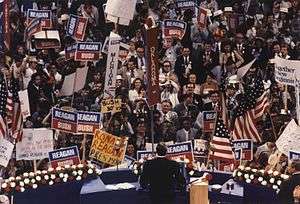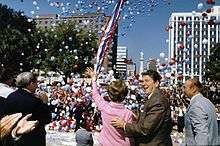Ronald Reagan 1980 presidential campaign
Ronald Reagan, the 33rd Governor of California (served 1967–1975), announced his candidacy for President of the United States in New York City on November 13, 1979. On July 17, 1980, he became the nominee of the Republican Party for the 1980 presidential election.[2] After receiving the Republican nomination, he selected one of his opponents in the primary elections, George H. W. Bush, to be his running mate.
| Reagan & Bush | |
|---|---|
 1980 Reagan-Bush campaign logo | |
| Campaign | 1980 Republican primaries 1980 U.S. presidential election |
| Candidate | Ronald Reagan 33rd Governor of California (1967–1975) George H. W. Bush 11th Director of Central Intelligence (1976–1977) |
| Affiliation | Republican Party |
| Status | Announced: November 13, 1979 Official nominee: July 17, 1980 Won election: November 4, 1980 |
| Key people | William J. Casey (Manager) Edwin Meese III (Chief of Staff) Richard V. Allen (Foreign Policy Adviser) |
| Slogan | Let's Make America Great Again Are You Better Off Than You Were Four Years Ago? The Time Is Now for Strong Leadership[1] |

On November 4, 1980, Reagan carried 44 of 50 states and received 489 electoral votes to win the election. Jimmy Carter, the incumbent president, carried six states, as well as Washington, D.C., and received 49 electoral votes.[3] Reagan won 50.7 percent of the popular vote, Carter took 41 percent, and Independent John B. Anderson (a liberal Republican) received 6.7 percent.[3] Reagan's election as President was completed with the meeting of the Electoral College on December 15, 1980,[4] and with the subsequent certification of the college's vote by the Joint session of Congress on January 6, 1981.[5]
Chronicle
Primaries
Reagan announced his candidacy for President of the United States in New York City on November 13, 1979.[6]
End of the primaries
On May 20, 1980, after the Michigan and Oregon primaries, Ronald Reagan secured enough delegates to clinch the nomination for the Republican Party. His opponent in the general election, incumbent President Jimmy Carter, passed the delegate threshold to become the presumptive nominee of his party on June 3. On May 26, George H. W. Bush, Reagan's remaining opponent for the Republican nomination, conceded defeat and urged his supporters to back Reagan.[7]
Vice Presidential selection
-1.jpg)
Ronald Reagan's choice for vice presidential running mate had been a subject of speculation since the end of the primaries. When former President Gerald Ford revealed in a CBS interview with Walter Cronkite that he was seriously considering the vice presidency, Ford garnered a great deal of interest. However, after Ford suggested the possibility of a "co-presidency" and, in addition, insisted that Henry Kissinger be re-appointed as Secretary of State and that Alan Greenspan be appointed as Secretary of the Treasury, negotiations to form a Reagan-Ford ticket ceased. Less than twenty-four hours before Reagan had formally accepted the Republican nomination, he telephoned George H. W. Bush to inform Bush of his intent to nominate him. The following day, on July 17—the final day of the Republican National Convention—Reagan officially announced Bush as his running mate.
Republican National Convention

The 1980 Republican National Convention convened at Joe Louis Arena in Detroit, Michigan. Reagan accepted the Republican nomination on the final day of the convention:
"With a deep awareness of the responsibility conferred by your trust, I accept your nomination for the presidency of the United States. I do so with deep gratitude, and I think also I might interject on behalf of all of us, our thanks to Detroit and the people of Michigan and to this city for the warm hospitality they have shown. And I thank you for your wholehearted response to my recommendation in regard to George Bush as a candidate for vice president."
Opinion polling
Weeks before the election, Reagan trailed Carter in most polls. In the Gallup poll on October 26, Jimmy Carter was at 47 percent and Ronald Reagan at 39 percent.[8] Following his sole debate with President Carter on October 28, Reagan overcame the largest deficit since Gallup polling began in 1936,[9] and within one week, the Associated Press reported that the race was "too close to call". Three weeks before the election, Yankelovich, Skelly and White produced a survey of 1,632 registered voters showing the race almost dead even, as did a private survey by Caddell.[10] Two weeks later, a survey by CBS News and the New York Times showed a similar situation.[10] Although some pollsters reported a slight Reagan lead, ABC News-Harris surveys consistently gave Reagan a lead of a few points until the climactic last week of October.[10]
Political positions

The United States in the 1970s underwent "stagflation"—a wrenching period of low economic growth, high inflation and high interest rates and intermittent energy crises.[11] Reagan was an adherent of supply-side economics, which argues that economic growth can be most effectively created using incentives for people to produce (supply) goods and services, such as adjusting income tax and capital gains tax rates. Accordingly, Reagan promised an economic revival that would affect all sectors of the population. Reagan theorized that cutting tax rates would actually increase tax revenues because the lower rates would cause people to work harder as they would be able to keep more of their money.
Reagan called for a drastic cut in "big government" and pledged to deliver a balanced budget for the first time since 1969. In the primaries, Bush famously called Reagan's economic policy "voodoo economics" because it promised to lower taxes and increase revenues at the same time.
.svg.png)
Controversy
Since the 1980 election, the 1980 campaign has been used as an example of dog whistle rhetoric by some. During the campaign, Reagan used the term "state's rights", and also referred to "Cadillac-driving 'welfare queens'" and "'strapping young bucks' buying T-bone steaks with food stamps".[12] These actions are also seen by some as an extension of a "Southern Strategy" developed by President Richard Nixon to garner white support for Republican candidates.[13][14][15][16]
Reagan's supporters have pointed out their belief that this was his typical anti-big government rhetoric, without any racial context or intent.[17] David Brooks noted the fact that Reagan had been courting black voters at the same time he was supposedly using this code language.[18] Reagan himself always denied he was a racist or was insensitive to the plight of the poor, writing that: "I was raised by a mother and father who instilled in me and my brother a hatred for bigotry and prejudice...we were poor in an era where there were no government programs to turn to."[19]
See also
References
- "The Living Room Candidate - Commercials - 1980 - Reagan's Record".
- "Time to Recapture our Destiny". Ronald Reagan Presidential Foundation & Library. July 17, 1980. Retrieved February 2, 2009.
- "1980 Presidential Election". University of Connecticut. Archived from the original on December 4, 2008. Retrieved February 2, 2009.
- "Electoral College chooses Reagan today". Pittsburgh Post-Gazette. 1980-12-15. p. 3. Retrieved February 2, 2009.
- Averill, John H. (January 7, 1981). "Congress Makes It Official—Reagan's the Winner". Los Angeles Times. Retrieved February 2, 2009.
- "Intent to Run for President". Ronald Reagan Presidential Foundation & Library. November 13, 1979. Archived from the original on January 24, 2009. Retrieved February 2, 2009.
- Ciccone, F. Richard (May 27, 1980). "Bush quits, backs Reagan". Chicago Tribune. Retrieved 2009-02-03.
- Harwood, John (October 12, 2008). "History Suggests McCain Faces an Uphill Battle". The New York Times. Retrieved February 3, 2009.
- Cohen, Jon (October 13, 2008). "Reagan's "Comeback"". The Washington Post. Retrieved February 3, 2009.
- Stacks, John F. (December 1, 1980). "Where the Polls Went Wrong". Time magazine. Retrieved February 3, 2009.
- Frum, David (2000). How We Got Here: The '70s. New York, New York: Basic Books. p. 292. ISBN 0-465-04195-7.
- Haney López, Ian (2014). Dog Whistle Politics: How Coded Racial Appeals Have Reinvented Racism and Wrecked the Middle Class. New York: Oxford University Press. p. 4. ISBN 978-0-19-996427-7.
- Lamis, Alexander P.; et al. (1990), "The Two Party South", Oxford University Press
- Herbert, Bob (October 6, 2005), "Impossible, Ridiculous, Repugnant", The New York Times, retrieved February 5, 2016
- Haney-Lopez, Ian. "The Racism at The Heart of the Reagan Presidency: How Ronald Reagan Used Coded Racial Appeals to Galvanize White Voters and Gut the Middle Class" Salon 1 Nov. 2014. Retrieved 18 January 2020.
- New Statesman, 27 June 2012, "Top Five Racist Republican Dog-Whistles," https://www.newstatesman.com/world/2012/07/top-five-racist-republican-dog-whistles
- "Reagan, No Racist", National Review, Deroy Murdock, Nov. 20, 2007.
- Brooks, David (November 9, 2007). ""History and Calumny"". The New York Times.
- Skinner, Kiron K.; Anderson, Annelise; Anderson, Martin, eds. (2004). Reagan: A Life In Letters. New York, New York: Free Press. p. 12. ISBN 978-0743219679.

